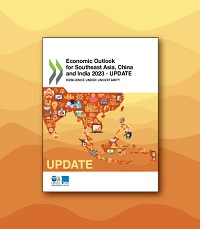 Growth in Emerging Asia needs to cope with external headwinds
Growth in Emerging Asia needs to cope with external headwinds
Emerging Asian economies will face challenges in coping with a persistent downturn in external demand. Exports in ASEAN experienced a substantial contraction amid a prolonged economic slowdown in advanced economies. Robust private consumption will remain the key driver of economic growth in the region.
The expanding services sector will also drive growth from the supply side, fuelling the region’s labour markets. The complete removal of travel restrictions is expected to stimulate rapid growth in the region’s tourism sector. Deeper integration of export markets within Emerging Asia and intraregional trade has helped the region cope with the impact of global economic slowdowns on its exports, though weakened external demand continues to pose a risk. Other persistent risks include geopolitical tensions, climate change and natural hazards.
Overall, real GDP growth in ASEAN will weaken in 2023, but outlooks will vary among countries. For instance, GDP growth in Indonesia should remain vigorous, while Myanmar’s growth momentum remains weak.
Regional and domestic demand supports growth
Domestic demand, in particular, private consumption, supported by high consumer confidence and an expanding middle-class, drives economic growth. Robust regional demand is keeping buoyant intraregional trade, helping the region sustain economic growth amid the slump in merchandise exports.
The share of service exports will continue to expand in the region, underpinned by the recovery of international tourism and the rapid development of emerging industries such as supply chainlinked services and cross-border services. Inflows of foreign direct investment (FDI) are expected to give a boost to the depressed export sector.
Financial markets are relatively stable but monetary policy manoeuvres must be conducted carefully
Despite headline inflation declining, core inflation persists in several countries in the region. Timely and appropriate monetary policies will help to tame consumer price index (CPI) pressures and sustain economic growth. Financial markets in Emerging Asia exhibit relative stability, though evolving monetary policies in advanced economies and global market volatility might pose challenges.
For instance, currencies in the region are recovering from a decline in their values in 2022, though risks of possible capital flight and continued portfolio outflows remain. Monetary policy makers must be mindful of this and handle policy adjustments carefully to ensure financial market stability and buoyant growth.
Labour markets show signs of recovery
The positive aspects of the outlook are all working together to stimulate labour markets in Emerging Asia. Unemployment is declining across the region, especially where populations are young and better educated. Policies to promote FDI for integration into global supply chains and global value chains will prove helpful, particularly in the electronics, textile and automotive sectors.


Leave a Reply